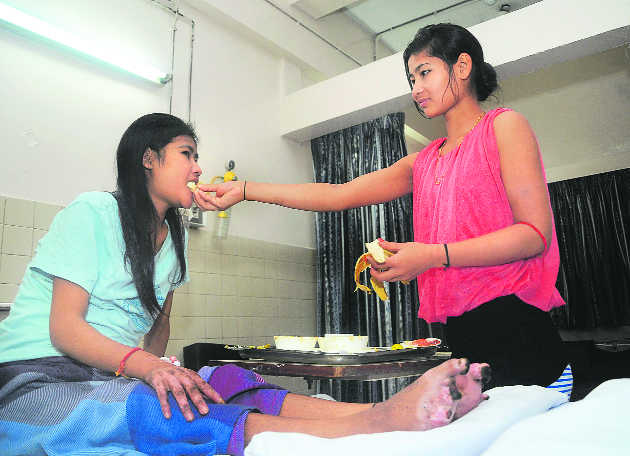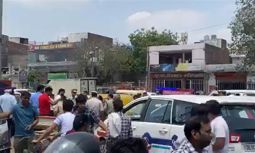
Risking limb and life: On the cusp of an international debut, 20-year-old Gohela Boro, a national-level archer, was afflicted with a rare disease, losing her toes and fingers and in the process her hopes for future. At present, she is under treatment at AIIMS, New Delhi
Sabi Hussain
She lies in her hospital bed staring at the wall, her eyes empty of all hope. Just a few months back, Gohela Boro, a national-level archer and winner of numerous medals, was on the cusp of participating in an international tournament. Those dreams are long gone, replaced by a bleak uncertainty about survival.
In November 2016 Gohela was diagnosed with a rare disease called Systemic Lupus Erythematosus (SLE) and Anti Neutrophil Cytoplasmic Antibodies (ANCA). It is an autoimmune disease in which the immune system attacks its own tissues. It can be fatal in some cases. In Gohela's case it caused decaying of her fingers and toes. The very fingers which could draw a taut string, hoping to shoot for glory, cannot even hold a spoon now. She has lost almost all her toes, save two or three. Her fingers have also been affected. The disease is slowly attacking her other organs too.
Recently admitted to the All-India Institute of Medical Sciences (AIIMS), Gohela, a 2015 Kerala National Games multi-medallist, including gold, is not sure if she would ever represent her state and the country ever again.
Learning about her plight, an NGO, Discovery Club, based in Kokrajhar, Assam, approached the sports administrators to ensure a better treatment for her. But nothing came out of it. The NGO turned to social media for a crowd-funding campaign, which paid for her initial treatment at the Gauhati Medical College. When her condition deteriorated there, she was referred to the AIIMS.
Only after her plight was highlighted by the media and the social media, that the Sports Ministry and the Sports Authority of India (SAI) came forth to help her.
"The Sports Ministry has assured us of all financial help, though it's just a verbal assurance. No funds have been released in advance to clear Gohela's regular medical bills," says Morin Z Dai, co-founder of the NGO helping Gohela.
Not just her medical condition, her future is a cause of worry for Gohela's family. Even if she is ever able to pursue her game in future, she may have to compete as a para-athlete.
"There's no recognition and financial support for para-athletes. Her parents are daily-wage labourers. How would they manage Gohela's future medical expenses? We will request the Ministry and the Assam Government to provide her a government job so as to live a dignified life," adds Dai.
But more immediate problems stare at Dai and Gohela's family members. Her daily medical expenses range between Rs 5,000 and Rs 10,000. Gohela might remain at the AIIMS for couple of months more. The cost of treatment could run up to Rs 5 lakh. "We met the sports secretary, who assured us that the AIIMS would not charge us anything, and the ministry would foot her complete medical bill. But there's little clarity on this issue between the Ministry and the AIIMS’ staff. We have paid for the medical tests. So far, AIIMS hasn't charged for the medicines, but we are apprehensive that we may have to pay the bills later as there's nothing in writing," says a worried Dai.
While Gohela might just get a tad lucky in getting government aid, our governments and sports authorities usually don't have a good track record of helping players once the spotlight has faded. Many international and national-level players have lived and died in penury, at times, fighting a losing battle against life itself.
Usually, the authorities only stir to life after the plight of such sporting heroes is taken up by the media or goes viral on social networking sites.
Gohela is not alone; there have been many more — M A Salam, Shankar Laxman, Mohammed Shahid, Rajiv Mishra, Dingko Singh, Buli Basumatary and maybe many others. They all have suffered due to the government's apathetic approach. These now forgotten sportspersons, secured several medals for India, but were left to fend for themselves by the sports administrators when they were faced with extreme penury and life-threatening disease or injuries.
Funding policy
Don't the governments — both Union and the state — have a defined insurance policy or a contingency fund earmarked for sportspersons to finance them in their hour of crisis? While the union government does have a policy, wherein a sportsperson is entitled to a medical insurance of up to Rs 5 lakh and a personal accident cover of up to Rs 25 lakh, there is a catch. Not all sportspersons are covered under the insurance or the accident policy. Those who have been part of the national camps and have represented India globally in multi-sport events fall under this bracket. Any other promising athlete, who doesn't make the cut, and gets ill or injured during his playing days, he/she wouldv have to foot his/her own bills.
First pay, then claim
But even then the insurance amount that top athletes are entitled to isn't easily available to them. The usual government practice is that initially the athlete will have to pay for the treatment and then claim reimbursement. But bureaucratic tangles have almost become a tradition in most such cases.
"My father passed away in December last year waiting for a better treatment. When I had first approached the Ministry and the All India Football Federation (AIFF), they assured me of immediate financial help. But, finally, when the cheque arrived from the Ministry after a media uproar, it was too late for us," rues Kaleem, son of footballer MA Salam.
Salam was one of the stalwarts of the 1956 Melbourne Olympics Indian football team. The team had scripted a golden chapter after reaching the semi-finals after defeating hosts Australia 4-2.
The Hyderabadi footballer was suffering from Alzheimer's. In 2012, his condition worsened after a fall in the bathroom, causing a hip fracture. It left him bed-ridden till he breathed his last in December 2016.
Another legendary hockey player, Mohhamed Shahid, part of team which got the gold at 1980 Moscow Olympics, met a similar fate. He suffered from some serious liver and kidney ailments and needed a transplant. The expected expenditure was of several lakhs. Neither the government nor his employer, the Indian Railways, came to his aid.
It was only after the media highlighted his suffering, and some former hockey players wrote to Prime Minister Narendra Modi about his condition, that the Ministry and the Railways came forward to help him. Sadly, Shahid couldn't survive long and passed away in July last year.
More recently, 1998 Asian Games gold medallist, boxer Dingko Singh, sold his flat at a throw-away price of Rs 10 lakh to pay for a costly treatment for liver cancer. Dingko, an Arjuna awardee and a Padma Shri, underwent a 14-hour-long surgery for his damaged liver at the AIIMS in January this year. The former Navy man has now mortgaged his ancestral home to fund his chemotherapy.
"All we have got is Rs 50,000 from the SAI. Dingko is a coach with the SAI in Imphal. Sports Minister Vijay Goel had assured us of an assistance of Rs 10 lakh, but it seems it was a mere assurance. The cheque hasn't arrived as yet. We are in deep financial crisis," says Dingko's wife Babai.
Blame it on budget
There has hardly been any increase in the sports budget since the past four years. The budgetary allocation in 2014-15 was Rs 1,643 crore. It was reduced to Rs 1,541.13 crore in 2015-16. It was marginally increased to Rs 1,592 crore in 2016-17. For 2017-18, the government has allocated Rs 1943.21 crore. Out of this Rs 350 crore has been earmarked for Prime Minister's flagship programme "Khelo India" for holding championships at school and college-levels.
"The federations don't get enough funding. Whatever little we get is spent on organising national camps, holding championships and sending players on exposure trips. We, ourselves, struggle for funds, helping our own athletes isn't possible when they have medical bills running into lakhs. The Ministry can help despite budgetary constraints, but the intention has to be there," says a senior federation official.
Another federation official says that the insurance companies are reluctant in extending health benefits to athletes competing in 'power sports'. "Boxers, weightlifters and wrestlers don't get the insurance policy easily, as they are 'high-risk category' individuals with a greater chance of suffering a life-changing injury," the official added.
BCCI sets an example
Despite getting bad press recently for various reasons, the BCCI has been doing a wonderful job of taking care of its players. The players, even at the Ranji-level, are insured. Under the 'medical benevolent fund', all cricketers, who have played 10 or more first-class matches, are eligible for medical reimbursement upto Rs 5,00,000 during their lifetime. Between July 2013 and April 2015, the BCCI bought insurance policies worth Rs 3,382.98 crore and paid a premium of Rs 11.68 crore, covering the players' mediclaim, personal insurance policy and loss of fees due to injury. It has insured a sum of Rs 187 crore under "special contingency insurance for players' loss of fees due to injury".
The BCCI's group insurance policy came handy for Bengal Under-19 cricketer Ankit Keshri, who died recently due to an on-field collision in a club game in Kolkata. The Board gave Rs 25 lakh compensation to his family.
These sportspersons go beyond the physical and mental limits to achieve excellence. Thus their chances of getting injured are greater. They got us the glory and the medals many times but now when the race has been run it becomes the nation's responsibility to take care of its injured heroes.
Way out
The Sports Ministry should learn something from the BCCI. It should prepare a list of elite and promising athletes and provide them with a group insurance cover. It should also set-up a 'medical fund' on the lines of the BCCI and use it to give aid, in case of any injury or illness to the player. Instead of reimbursing medical bills later, the Ministry should set aside a contingency fund, to provide immediate cash relief in case of medical emergencies. There can be tie-ups with top hospitals to provide affordable treatment to injured or ill players. The Ministry should also make easy the process of getting aid and do away with red tape.



























